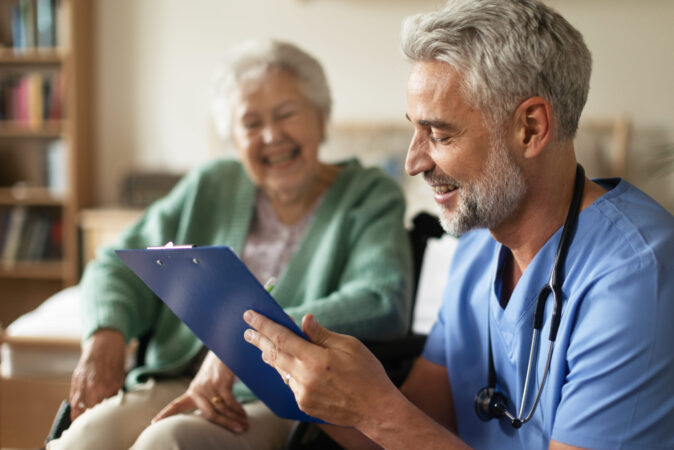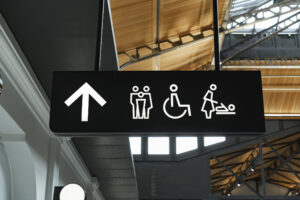Recovering from surgery can be more challenging than the surgery itself (thank goodness for anesthesia!)
For most people, falling is the greatest post-op safety hazard. Whether it’s an older adult recovering from a hip replacement, or a young athlete recovering from a leg procedure, everyone is at higher risk of falling when their mobility and stability have been impacted following surgery. That’s why it’s so important to prepare the home environment before surgery to make it safer for post-op recovery.
Whether you’re a caregiver, a care facility, or the person being operated on, you can print or share this useful home safety checklist to make sure you’ve got everything prepared!
At the bottom of this page, you can check out NOVA’s home safety toolbox for even more actionable information.
Home Safety Checklist
Mobility Aids
- Cane
- Walker
- Wheelchair
- Rollator
- Knee scooter
- Mobility Accessories – Cup Holders, Food Tray, Bags
Clear Pathways
- Items picked up off floor
- Furniture moved to make clear walkways in home
- Walkways wide enough for mobility aids
- Low-lying furniture pushed aside
- Rugs removed
- Loose carpet removed / stapled
Lighting
- Remote-powered lights in bedroom
- Nightlights in bedroom and hallways
- Motion-activated lights in bedroom and bathrooms
- Landscape lighting in garden, patio, and outdoor areas
- Flashlight attachment for mobility aid
Bathroom Safety
- Toilet rails
- Grab bars in shower / bathtub
- Non-slip mat in shower / bathtub
- Bath chair
- Transfer bench
Recovery in Bed
- Overbed Table
- Bed Safety Rail
- Bed Wedges for the back and legs
- Waterproof Underpads
- Urinals and Bedpans
- Bedside Commode
Mobility Aids Explained
A mobility aid is an essential recovery tool for many types of surgeries, especially those that will limit one’s movement or stability.
Common mobility aids include:
- Canes
- Wheelchairs
- Walkers
- Rollators
- Knee scooters
Something important to remember: hip and lower-body surgeries aren’t the only procedures that warrant mobility aids. Mobility aids are useful for any type of surgery that’s going to weaken your body strength for a short or longer term.
Falling can hinder your recovery or cause an injury that’s worse than the health problem you had surgery to fix. Finding a durable and ergonomic mobility aid before your surgery is crucial in making sure your post-op recovery is a success.
Clear Pathways: Explained
It’s difficult to use mobility aids inside the home when there’s not enough space to accommodate them. Whether you’re using a cane, walker, or different kind of device, it’s important to clear pathways throughout the home to reduce tripping hazards and make it easier to use mobility aids.
Picking up items off the floor, removing rugs, fixing patches of loose carpet, and pushing aside low-lying furniture (like coffee tables) are helpful for preventing falls.
Proper Lighting: Explained
So many falls happen in low light. Someone with limited mobility can trip over something when they’re moving around in the darkness. Usually, it’s after they’ve flipped the lights off or before they’ve flipped the lights on.
Remote-powered lights, night lights, and motion-activated lights can make the home safer at nighttime or in rooms that get little sunlight. Ideally, these will be battery-powered or solar-powered, so they’ll continue to work in the event of a power outage.
It might also be helpful to add a flashlight attachment to a cane or walker.
Bathroom Safety: Explained
Bathrooms can be challenging and even hazardous for people recovering from surgery. Using the toilet may require support, stability or leg strength that has been diminished post-op. Getting in and out of the bathtub may also require support and taking a standing shower may be difficult and also a significant slipping hazard.
Safety equipment like grab bars, toilet rails, bath mats, bath chairs, and transfer benches make it so much easier and safer to use our bathroom when recovering from surgery.
Recovery in Bed: Explained
Getting good rest is essential to a successful recovery, but may be one of the most frustrating and painful parts of recovery. While getting a good night’s rest in your own bed is normal, this changes drastically post-op.
Let’s start with comfort in bed and getting a good night’s rest. The normal resting positions can now be very painful and require cushion support. Most people try to use bed pillows to do this, but find they just don’t do the job. Bed wedges are specifically designed to give the body the ideal support that will allow for better rest and sleep.
Recovery in bed will often include many meals, doing work, watching TV, reading and sharing time with friends and loved ones. Products such as an overbed table and bed safety rail make that time in bed much more safe, convenient and comfortable.
Post-op recovery can also make it difficult to get to the toilet, especially at night. Urinals and bedpans can solve this issue and underpads can protect the mattress from any accidents and leaks. A bedside commode is also a great option and much easier to access than the toilet in the bathroom. The foldable option make is easy to store it away when not in use.
Download the Ultimate Home Safety Toolbox by NOVA
Want to learn more about preventing falls at home and optimizing for a safe and successful recovery? Check out our Home Safety Toolbox, which has resources available for caregivers and care facilities—all part of NOVA’s mission to empower human ability.



